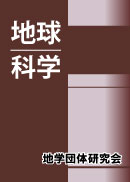All issues

Volume 24 (1970)
- Issue 6 Pages 191-
- Issue 5 Pages 151-
- Issue 4 Pages 115-
- Issue 3 Pages 79-
- Issue 2 Pages 43-
- Issue 1 Pages 1-
Volume 24, Issue 3
Displaying 1-6 of 6 articles from this issue
- |<
- <
- 1
- >
- >|
-
Teruo HIRABAYASHIArticle type: Article
1970Volume 24Issue 3 Pages 79-92b
Published: May 25, 1970
Released on J-STAGE: July 26, 2017
JOURNAL FREE ACCESSDownload PDF (3539K) -
Mitsuo HATA, Yasuo HASEGAWAArticle type: Article
1970Volume 24Issue 3 Pages 93-103
Published: May 25, 1970
Released on J-STAGE: July 26, 2017
JOURNAL FREE ACCESSUp to date the geology and palaeontology of the Okushiri Island off Hokkaido has been studied by some investigators. The writers carried out the geological review and the study of the Tertiary marine diatoms collected from the southern area of this island. The conclusions are as follows: (1) In the geological survey the upper part of the Senjo Formation consisting of siltstone and the Muejitna Formation called by (SUZUKI and SONOKI, 1936) seem to be synchronous and heterofacies to each other. Then these facies were newly unified by one of the writers, Hata, as the Yoneoka Formation. (2) The two samples from the Yoneoka Formation is clearly distinguished by dominant and characteristic diatom species, Coscinodiscus marginatus, Denticula kamtschatica and the genus Thalassiosira (T. antiqua, T. decipiens, T. nidulus, T. oestrupi and T. zabelinae). No combination of species composition of four categories (21 diatom taxa in a random count of 200 marine planktonic species) used by KOIZUMI (1968) for recognition of the diatom zones in Tertiary sediments on the Oga Peninsula, Akita Prefecture, Northeast, Japan, occurs in this formation. The Yoneoka samples may be correlated with the assemblage of the Maido Formation (upper Miocene) of the Ajigasawa district, Aomori Prefecture, Northeast Japan, studied by Koizumi, (1966) corresponding to the Kitaura Formation of the Oga Peninsula. (3) The Tsurikake Formation are characterized with the six extinct species, Denticula nicobarica, Cosmiodiscus intersectus, Synedra jouseana, Thalassiosira cfr. kisselevii, T. usatschevii and Stephanopyxis lineata. This formation is assumed to be represent the lower part of the middle Miocene of this area, according to the palaeontological evidences of the molluscan fauna and the planktonic foraminifers of the Nishikurosawa's type (Gobigerina praebulloides, G. scitula and Sphaeri dinellopsis subdehiscens). (4) The ranges of following species, Denticula kamtschatica, Cosmiodiscus intersectus, Synedra jouseana, Thalassiosira usatschevii and T. zaberinae, reported byJoust (1962) to be restricted to the Pliocene are found to extend into the Miocene in this area, though already their ranges was reported by KOIZUMI (1966) in the Northeast Japan and SHESHUKOVA-PORETZKAYA (1967) in Sakhalin and Kamtshatka of the Far East. The predominant species, Denticula nicobarica, of the Tsurikake Formation also was reported by SIMONSEN and KANAYA (1961) to occur in the uppermost Miocene in California, U.S.A.View full abstractDownload PDF (4466K) -
Kenji YAIRI, Hisato OSAWA, Hirotaka UIArticle type: Article
1970Volume 24Issue 3 Pages 104-109
Published: May 25, 1970
Released on J-STAGE: July 26, 2017
JOURNAL FREE ACCESS -
14C Age of the Quaternary Deposits in Japan (54)Makio YANO, Ikuo FUJITAArticle type: Article
1970Volume 24Issue 3 Pages 110-111
Published: May 25, 1970
Released on J-STAGE: July 26, 2017
JOURNAL FREE ACCESSDownload PDF (289K) -
14C Age of the Quaternary Deposits in Japan (55)Makio YANOArticle type: Article
1970Volume 24Issue 3 Pages 111-112
Published: May 25, 1970
Released on J-STAGE: July 26, 2017
JOURNAL FREE ACCESSDownload PDF (267K) -
14C Age of the Quaternary Deposits in Japan (56)Seiji MATSUI, Tatsuo INOUEArticle type: Article
1970Volume 24Issue 3 Pages 112-114
Published: May 25, 1970
Released on J-STAGE: July 26, 2017
JOURNAL FREE ACCESSDownload PDF (476K)
- |<
- <
- 1
- >
- >|